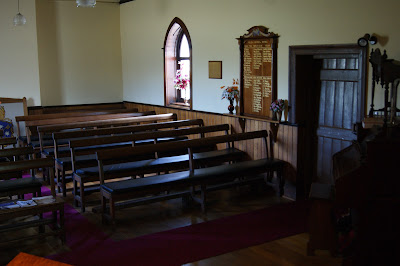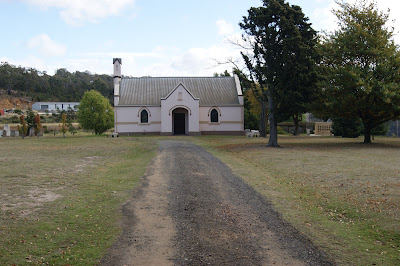In fact, several local residents had already asked the Chaplain of Perth, the Rev Alfred Stackhouse, to arrange a service for them in the village each Sunday. He agreed and placed the request before the first Bishop of Tasmania, Francis Nixon who had arrived in the colony in July 1843. The Bishop agreed providing there was a suitable place for the conduct of the church services.
In September 1844, Bishop Nixon visited the north and talked to his friend, the Rural Dean, Rev R.R Davies of Longford. Together they planned 10 new churches in the region. The first to be constructed was the Franklin Village Chapel. The design of the chapel was attributed to architect William Henry Clayton of Longford. St James, as it was later named, was the 7th Anglican Church to be built in Van Diemens land and it is believed to be only one of three Anglican churches in the state to have a fireplace within the church itself.
Land for the church was donated by Mr Britton Jones who donated a gift of 1 acre to the Bishop of Tasmania for “a school and for the celebration of divine worship according to the rites and ceremonies of the United Church of England & Ireland and for a place of burial”’
The ground was presented to the Bishop by Mary, daughter of Mt Britton Jones. Funds for the construction of the chapel were raised by schoolmaster Mr William Keeler Hawkes and Mr John Smith of the property “Marchington” supplemented by a grant from the English Society for the propagation of Christian Knowledge.
The foundation stone was laid by the Bishop on 12 October 1844 in front of the Rural Dean, a number of clergymen and 300 other persons. In just 6 months after the foundation stone was laid, the new building was formally opened on 15th April 1845. At the entrance to the church, Bishop Nixon was presented with a petition from the residents requesting his Lordship to open the building for the conduct of services. After the opening service was completed, the Bishop, accompanied by the clergy present walked around the burial ground and proceeded to consecrate the ground. However, on this occasion the church itself was not consecrated or named. It was referred to as the Franklin Village Chapel until 1926 when it was dedicated and officially named St James Church.
A major restoration was carried out in 1985 at a cost of $10,000. The restored church was officially re-consecrated by Bishop Newell in February 1986. Further restoration was undertaken in 2010 using a grant of $20,000 from the Tasmanian Community Fund. There are many memorials and rolls of honour in the church, including the stained glass windows and many of the names on these memorials are recognizable from the contributions of the families to the local community. Headstones in the graveyard include family names that were well known pioneers in the district. Graves for the likes of William Keeler Hawkes and his family are very prominent within the graveyard. However, there are still many unmarked graves within the yard.
Services continued to be conducted at the church as part of a combined parish service that rotates around three parish churches. The restorations have been wonderful and the chapel to this day is in a remarkable condition for a church that has been active consistently for the past 170 years. It forms a very essential heritage element of Franklin Village and, along with Franklin House which is on the opposite side of the road, is a reminder of its important historical past.
Main Text & information Source –
“Franklin Village – A Journey in Time” – Terry Childs (Revised 2013)
Available to purchase at the Franklin House Onsite Shop.














